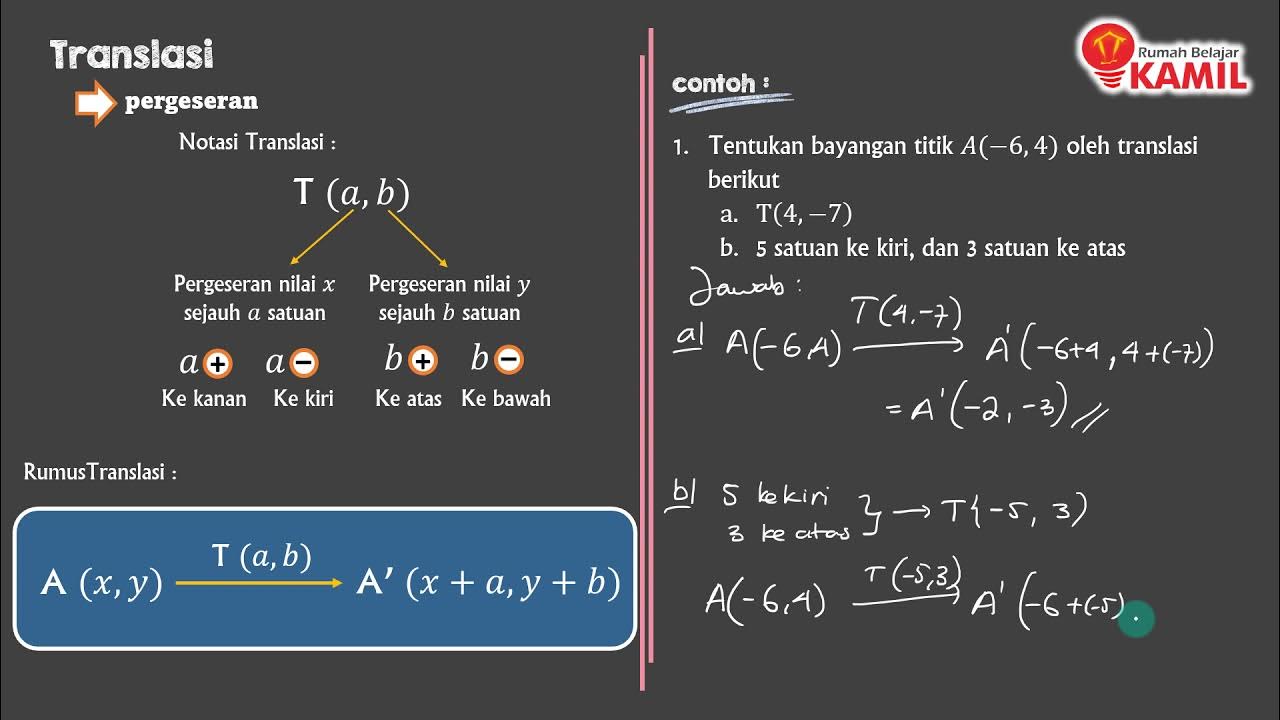TRANSFORMASI FUNGSI PART 1
Summary
TLDRThis educational video explores the concept of geometric transformations, revisiting the topic from middle school. It covers four types of transformations: translation, reflection, rotation, and dilation. Translation involves moving an object along a straight line without changing its size or shape. Reflection is a mirror image across a line, maintaining the object's form but reversing its orientation. Rotation turns an object around a center point by a specific angle, while dilation changes the size of an object by a scaling factor without altering its shape. The video aims to clarify these concepts with examples, hoping to enhance understanding of geometric transformations.
Takeaways
- 📚 The lesson covers the topic of geometric transformations, which include changes in the shape, position, and size of an object.
- 🔄 There are four types of transformations discussed: translation, reflection, rotation, and dilation.
- 🔑 Translation is the movement of an object along a straight line without changing its size or shape.
- 🪞 Reflection is the mirror image of an object, where the distance from each point to the mirror is equal to the distance from the mirror to its image.
- 🔄 Rotation involves turning an object around a central point by a certain angle, which can be positive (counterclockwise) or negative (clockwise).
- 📐 Dilation is the transformation that changes the size of an object by a scaling factor, without altering its shape.
- 📏 In translation, the shape and orientation of the object remain the same after the movement.
- 🔄 Rotation changes the position of the object but maintains its shape and proportions.
- 🔍 Dilation can either enlarge or reduce the size of an object, depending on the scaling factor applied.
- 🤔 The properties of reflection, such as the distance from the object to the mirror and the orientation of the image, are emphasized.
- 📐 The lesson aims to ensure understanding of these geometric transformations, which are fundamental in mathematics.
Q & A
What is the main topic of the video script?
-The main topic of the video script is the concept of geometric transformations, including translation, reflection, rotation, and dilation.
What is a translation in geometry?
-A translation in geometry is the process of moving an object along a straight line by a certain distance without changing its shape or size.
Can you give an example of a translation from the script?
-An example of translation given in the script is moving a triangle along a line to a new position, resulting in a new shape that is the image of the original triangle.
What is reflection in the context of geometric transformations?
-Reflection, also known as mirroring, is the process of mapping each point of a shape to its mirror image across a line or plane, thus changing the direction but not the shape or size.
How does the script describe the properties of a reflection?
-The script describes the properties of a reflection as having equal distances from each point to the mirror line and from the mirror line to its image, and changing the direction of the points without altering the shape or size.
What is rotation in geometric transformations?
-Rotation is the process of turning or spinning a shape around a fixed point, known as the center of rotation, by a certain angle.
How is the rotation of a shape represented in the script?
-In the script, rotation is represented by 'R' with a subscript indicating the center of rotation (P) and the angle of rotation (Teta), such as R(P, Teta).
What is dilation in geometric transformations?
-Dilation is the process of enlarging or reducing a shape by scaling the distances from a central point, called the center of dilation, by a certain factor.
How does the script explain the effect of dilation on a shape?
-The script explains that dilation changes the size of a shape but does not alter its shape, as it uniformly scales all distances from the center of dilation.
What is the significance of the angle in rotation as mentioned in the script?
-The angle in rotation determines the extent to which a shape is turned. If the angle is positive, the rotation is counterclockwise, and if it is negative, the rotation is clockwise.
How does the script conclude the lesson on geometric transformations?
-The script concludes by expressing hope that the viewers have understood the material and ends with a traditional closing phrase, 'Wasalamualaikum warahmatullahi, wabarakatuh'.
Outlines

This section is available to paid users only. Please upgrade to access this part.
Upgrade NowMindmap

This section is available to paid users only. Please upgrade to access this part.
Upgrade NowKeywords

This section is available to paid users only. Please upgrade to access this part.
Upgrade NowHighlights

This section is available to paid users only. Please upgrade to access this part.
Upgrade NowTranscripts

This section is available to paid users only. Please upgrade to access this part.
Upgrade NowBrowse More Related Video

Aula 03 - Reflexão da Luz

PEMBUKTIAN TRANSFORMASI | Geometri Transformasi #2

Cara Cepat Memahami Transformasi Geometri [Matematika Kelas IX]

Matematika Kelas 9 : Transformasi Geometri (part 1 : Translasi)

GARIS DAN SUDUT (PART 1)

Transformasi Geometri Bagian 3 - Rotasi (Putaran) Matematika Wajib Kelas 11
5.0 / 5 (0 votes)